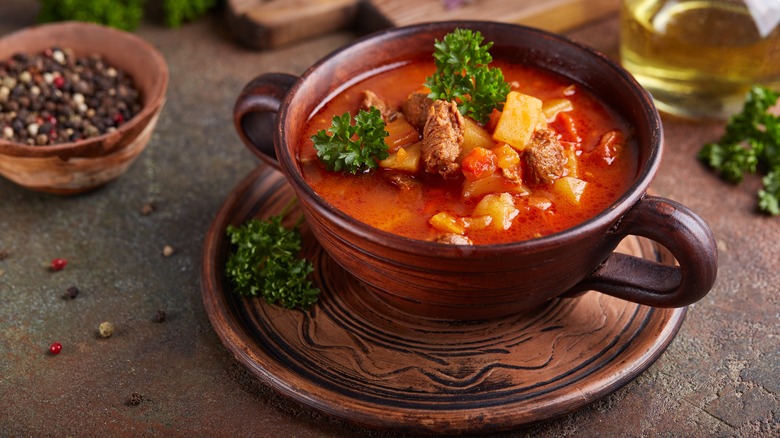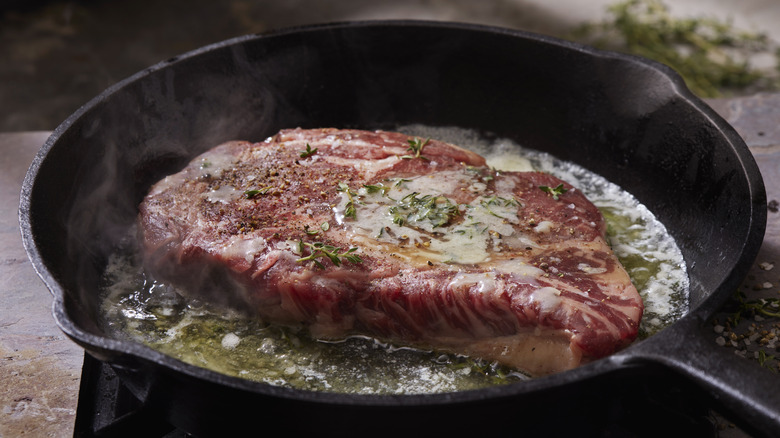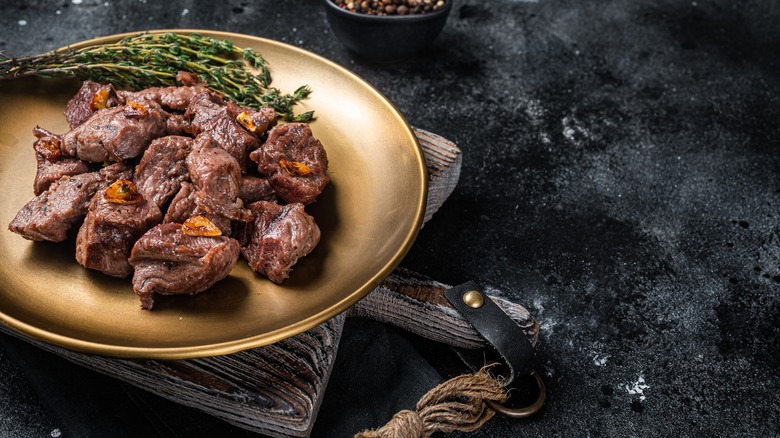The Browning Shortcut For Restaurant-Worthy Beef Stew
When it comes to browning beef for your stew, the whole is definitely greater than the sum of its parts. In this case, it saves time and tenderness if you brown the beef while it's still whole and then cut it into pieces post-browning to put into the stew. Many recipes call for it to happen the other way around. That is, they say to cut up the meat and then brown it — although this can make the beef dry and chewy.
It's also worth mentioning that, unfortunately, stew meat – usually round or chuck steak – tends to be a tough cut of meat to begin with. Once you put the meat into the hot pan, often at temperatures of 300 F, any moisture on the surface of the steak begins to steam like a locomotive in a steampunk novel. Such steam works great for moving a fictional story forward and even for cooking your meat, but it doesn't brown it.
Browning the meat gives it extra flavor, and you want that flavor to eventually seep into the other ingredients in the stew when you cook it. But the longer the chunks of steak beef steam at high temps, the tougher the meat becomes. Eventually, the surface-level moisture that causes the meat to steam evaporates, and then the Maillard reaction gets going, but by then, it's too late. It's tough as a horse's saddle.
Why cooking it whole works better
If you want the meat to change color while you cook it, then the surface of the steaks must be pat dry in order for the Maillard reaction to get going. Cooking the steaks whole slows down the loss of moisture that steams the meat. Instead, the moisture stays inside the meat, keeping the steaks tender while browning the exterior. The stew meat can then benefit from cooking slowly in the broth. It becomes almost as tender as the best cuts of steak without the price tag that comes with a good cut of beef.
There's also another advantage to cooking the steaks whole instead of cubing then cooking them. Cooking the steaks whole means that you have the option to grill the steaks on the barbecue to get the Maillard reaction going. Browning the meat on the grill would be difficult if you cube the steak ahead of time.
In any case, whether you throw the meat on the grill or brown it in a pan, you now have the option of preparing the steaks like you were planning to eat them whole instead of as cubes of meat in a stew. In light of that, you'll want to follow the steps you normally take when you cook a steak. For example, salt it and let it rest, or dress a steak with olive oil or butter; do all of these things before you brown it.
Adding it to the stew
Once you're done browning the steak, give it time to breathe on the counter for a few minutes before cutting it up and tossing it into the stew. Doing this gives the muscle fibers in the meat time to relax. In the process, the moisture inside of the meat begins to work its way back through the meat. The result is meat that's more tender, something you want in stew meat.
Finally, cooking the recipe at a temperature that's low enough to allow the stew to simmer but not boil usually produces more tender meat. You have a couple of options to make this happen. The first option is to cook it so that the lid sits slightly askew on top of the pan. This lets some of the steam escape and keeps the temperature down in the process. Or put it into the slow cooker and let the stew bubble at a leisurely pace in its own juice for a couple of hours. Between using the right cutting hack and the proper cooking pace, you should end up with a pretty supreme-tasting bowl of stew.


